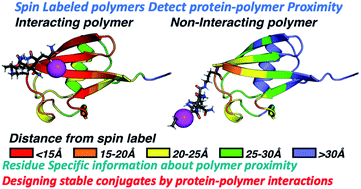Mapping protein–polymer conformations in bioconjugates with atomic precision†
Abstract
Rational design of protein–polymer bioconjugates is hindered by limited experimental data and mechanistic understanding on interactions between the two. In this communication, nuclear magnetic resonance (NMR) paramagnetic relaxation enhancement (PRE) reports on distances between paramagnetic spin labels and NMR active nuclei, informing on the conformation of conjugated polymers. 1H/15N-heteronuclear single quantum coherence (HSQC) NMR spectra were collected for ubiquitin (Ub) modified with block copolymers incorporating spin labels at different positions along their backbone. The resultant PRE data show that the conjugated polymers have conformations biased towards the nonpolar β-sheet face of Ub, rather than behaving as if in solution. The bioconjugates are stabilized against denaturation by guanidine-hydrochloride, as measured by circular dichroism (CD), and this stabilization is attributed to the interaction between the protein and conjugated polymer.

- This article is part of the themed collection: 2020 Chemical Science HOT Article Collection


 Please wait while we load your content...
Please wait while we load your content...